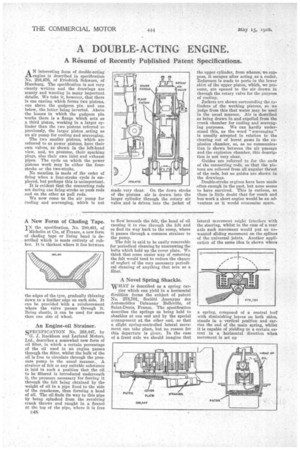A DOUBLE-ACTING ENGINE.
Page 70

If you've noticed an error in this article please click here to report it so we can fix it.
A Resume' of Recently Putdished Patent Specifications.
AN interesting form of double-acting engine is described in specification No. 288,47e, of Friedrich Schwarz, of Hamburg, The specification is not very clearly • written and the drawings are scanty and wanting in many important details. We take it, however, that there is one casting which forms two pistons, one above the 'gudgeon pin and one below, the latter being inverted. Above the bosses in which the gudgeon pin works there is a flange which acts as a third piston, working in a larger cylinder than the two pistons referred to previously, the larger piston acting as an air pump for cooling and scavenging.
The two smaller pistons, which are referred to as power pistons, have their own valves, as shown in the left-hand view, and, we, presume, their sparking plugs, also their own, inlet and exhaust pipes. " The cycle on which the power pistons work may be either the four stroke or the two-stroke. • ' No mention, is made of the order of firing when a four-stroke cycle is employed, but perhaps this is unimportant.
It is evident that the connecting rods act during one firing stroke as push rods and on the other as pull rods.
We now come to the air pump for Cooling and scavenging, which is not made very clear. On the down stroke of the pistons air is. drawn into the larger cylinder through the rotary air valve and is driven into the jacket Of the upper cylinder, from whence, we suppose, it escapes after acting as a cooler. Reference is made to ports in the lower skirt of the upper piston, which, we presume, are opened to the air drawn in through the rotary valve for the purpose of cooling.
Jackets are shown surrounding the Cylinders of the working pistons, so we judge from this that water may be used in the usual manner. Air is described as being drawn in and expelled from the crank chamber for cooling and scavenging purposes. We can hardly understand this, as the word " scavenging " is usually accepted in relation to the clearing out of burnt gases in the explosion chamber, so, as no communication is shown between the air passage and the explosion chamber, this description is not very clear.
Guides are referred to for the. ends of the connecting rods, so that the pistons are relieved from all angular thrust of the rods, but no guides are shown in the drawings.
Double-stroke engines have been made often enough in the past, but none seems to have survived. This iS curious, as there is little doubt that for coach and bus work a short engine would be an advantage as it would economize space.
A New Form of Chafing Tape.
IN the specification, No. 280,4D1, of Michelin et Cie, of France, a new form of chafing tape or lining band is described which is made entirely of rubber. It is thickest where it lies between the edges of the tyre, gradually thinning down to a feather edge on each side. It can be provided With a reinforcement where the valve passes through it. Being elastic, it can be used for more than one size of wheel.
An Engine-oil Strainer.
SPECIFICATION No. 288,447, by
G. S. Rackham and Leyland Motors, Ltd., describes a somewhat new form of oil filter, in which a certain percentage of the oil used in an engine passes through the filter, whilst the bulk of the oil is free to circulate through the pressure pump in the usual manner., A. strainer of felt or any suitable substance is laid in such a position that the oil to be filtered is introduced underneath it, the pressure necessary for forcing it through the felt being obtained by the weight of oil in a pipe fixed to the side of the crankcase, thus farming a head of oil. The oil finds its way to this pipe by being splashed from the revolving crank throws and caught in a funnel at the top of the pipe, where it is free
to flow beneath the felt, the head of oil causing it to rise through the felt and so find its way back to the sump, where it passes through a common strainer to the pump.
The felt is said to be easily removable for periodical cleaning by unscrewing the bolts which hold up the cover plate. We think that some easier way of removing the felt would tend to reduce the chance of neglect of the very necessary periodical cleaning of anything that acts as a filter.
A Novel Spring Shackle.
wliA.T is described as a spring car
rier which can yield in a horizontal direction forms the subject of patent No. 278,701, Societe Anonyme des Automobiles Delaunay Belleville, of Saint-Denis, Prance. TIM specification describes the springs as being held to shackles at one end and by the special arrangement at the other end, so that a slight spring-controlled lateral movement can take place, but no reason for this departure is given. In the case of a front axle we should imagine that lateral reavemeet might interfere with the steering, whilst in the case of a rear axlesuch movement would put an unwanted sliding movement on the splines of the universal joints. Another application of the same idea is shown where a spring, composed of a central leaf with diminishing leaves on both sides, stands in a vertical position and carries the end of the main spring, whilst it is capable of yielding to a certain extent in a horizontal direction when movement is set up












































































































